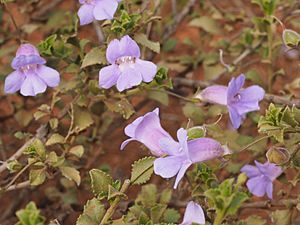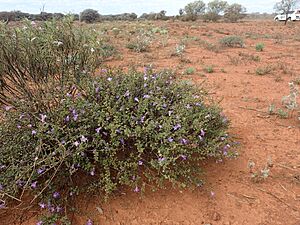Eremophila enata facts for kids
Quick facts for kids Eremophila enata |
|
|---|---|
 |
|
| Eremophila enata leaves and flowers | |
| Scientific classification | |
| Genus: |
Eremophila (plant)
|
| Species: |
enata
|
Eremophila enata is a beautiful flowering plant that belongs to the figwort family, called Scrophulariaceae. This plant is special because it is found only in the central parts of Western Australia. It grows as a low, spreading bush with leaves that have jagged edges and pretty purplish or pinkish flowers.
Contents
What it Looks Like
Eremophila enata is a bush that spreads out, usually growing less than 0.3 meters (about 1 foot) tall. Its stems feel rough and are covered in tiny hairs. The leaves grow one after another along the branches, with some space between them. They are shaped like an oval or an egg, usually about 9-20 millimeters (0.35-0.79 inches) long and 3-9 millimeters (0.12-0.35 inches) wide. The edges of the leaves are like tiny saw teeth, and their surfaces have special glandular hairs.
The flowers grow one by one where the leaves meet the stem. Each flower sits on an S-shaped stalk that is usually 8-25 millimeters (0.31-0.98 inches) long. There are five green to purplish sepals, which are like small leaves that protect the flower bud. These sepals are different sizes and shapes, mostly 2.5-6 millimeters (0.098-0.24 inches) long. The sepal at the back is egg-shaped and a bit shorter and wider than the others.
The petals are 16-20 millimeters (0.63-0.79 inches) long and are joined together at their bottom to form a tube. The outside of this tube is purple to pinkish-purple, while the inside is white with purple or reddish-brown spots. The outside of the petal tube is covered with glandular hairs, and the inside is filled with soft, woolly hairs. The four stamens (the parts that make pollen) are completely hidden inside the petal tube.
Eremophila enata flowers from August to October. After the flowers, it produces fruits that are oval or almost round. They are hairy, 8-11 millimeters (0.31-0.43 inches) across, and have a papery covering.

How it Got its Name
This plant was first officially described by a scientist named Robert Chinnock in 2007. He published its description in a book called Eremophila and Allied Genera: A Monograph of the Plant Family Myoporaceae. The first plant specimen used for this description was collected by Chinnock about 36 kilometers (22 miles) north of Wiluna.
The second part of the plant's scientific name, enata, comes from a Latin word meaning "arisen" or "born." This name was chosen because Eremophila enata looks very similar to another plant called E. gilesii.
Where it Lives
Eremophila enata is found near places like Wiluna and Windidda in Western Australia. These areas are part of the Gascoyne, Murchison, and Pilbara regions. This plant usually grows in clay soils, often in mulga woodlands, which are forests mainly made up of mulga trees.
Conservation Status
The Western Australian Government's Department of Parks and Wildlife has looked at Eremophila enata. They have classified it as "not threatened," which means it is not currently in danger of disappearing.
Growing it in Gardens
This type of eremophila plant produces many flowers, especially after rain when there has been a long dry period. Its beautiful flowers make it a great choice for many gardens. You can grow new plants from cuttings (small pieces of the plant). It grows best in soil that drains water well and in a spot that gets full sun. This plant can handle dry periods (drought) and some frost. If it gets damaged by frost, new growth usually appears quickly.

